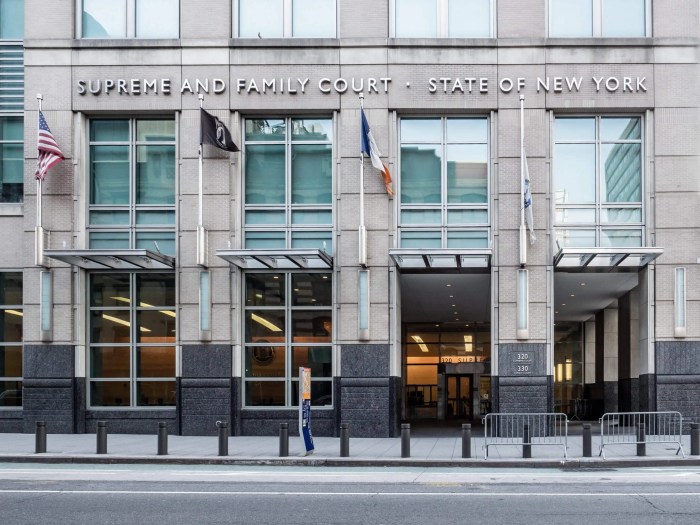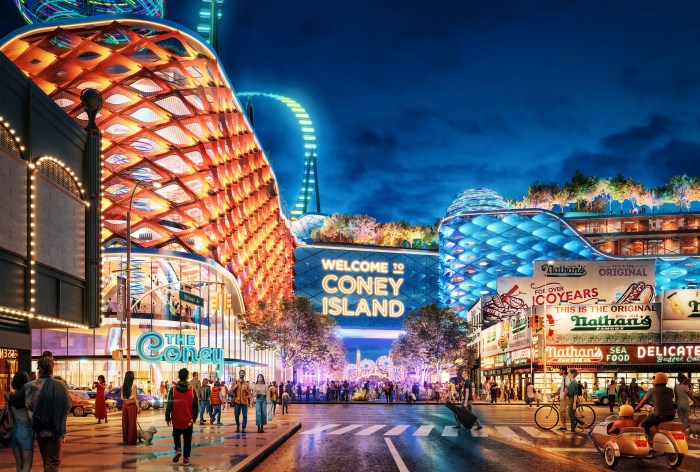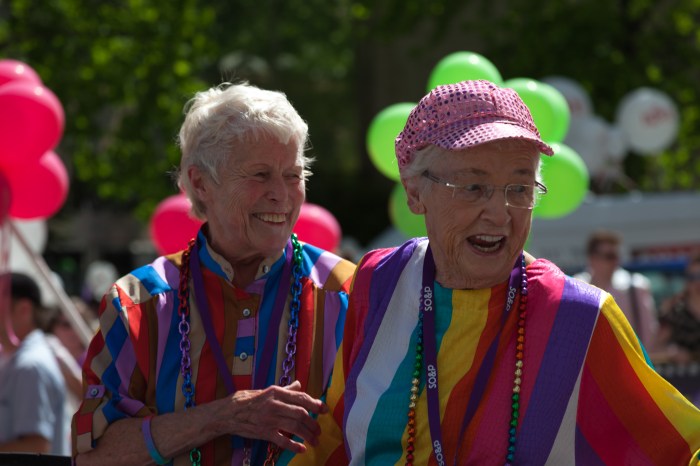The original co-developer of what was considered by many to be an architecturally
dazzling — if oversized — residential development planned for
100 Jay St. in DUMBO, says he was wronged by his former development partner.
Light Bridges at Jay Street, as the project was called when it was presented
to the community board and neighborhood groups in 2001, was the first
residential skyscraper proposed for the formerly industrial neighborhood.
After gaining the city’s approval in 2002 of the grand-scale zoning
change of the site — on a block bounded by Jay, York, Pearl and Front
streets — from a light manufacturing district to a high-density residential
site with lower floor commercial, the project paved the way for the currently
under construction era of skyscrapers in DUMBO.
The 375,000-square-foot condominium development was to have consisted
of two connected, 20-story towers with a common two-story base and an
interior courtyard. In addition to luxury condos, the complex — situated
next to the Manhattan Bridge overpass — would have contained retail
space on the first two full floors and commercial space on floors 3 and
4.
It was never built.
Jeffrey M. Brown, who was brought on to oversee design and development
of Light Bridges, now charges that his partner bargained in bad faith.
Brown was brought in as a co-developer of the project in 1999 by developer
Charlie Cara, according to court filings.
At the time, Brown said, he didn’t know Cara, or the architecture
firm of Sharples, Holden and Paquarelli, known as ShoP, which would design
Light Bridges.
Ever since negotiations to develop the site fell through in early 2003,
Brown and Cara have been embroiled in litigation over whether or not Brown,
a Philadelphia-based developer and designer, has any right to what gets
built there.
Since Light Bridges fell by the wayside, Brown has continued to work with
SHoP on award-winning buildings, including one on Ninth Avenue and 15th
Street in Manhattan and several in Philadelphia and New Jersey.
Cara, meanwhile, is building a taller but less adventurous luxury condo
on the site, called the “J Condo,” which, at 33 stories and
337 feet, will be the tallest building in DUMBO. It will house 267 one-
to three-bedroom apartments and ground-floor retail.
On July 28, the U.S. Court of Appeals dismissed several causes of action
made by Brown against Cara regarding 100 Jay St., but upheld one claim
for breach of contract. That suit is headed back to Brooklyn’s Eastern
District federal courthouse.
In an interview with The Brooklyn Papers, Brown explained why the much-anticipated
Light Bridges never saw the light of day.
“He [Cara] just retracted the deal after I did all the rendering
and work,” Brown said.
“We spent a tremendous amount of time and money on preparing this
[design], and the community loved it,” he said, pointing out that
Community Board 2 voted 30-0 to approve the zoning change, which has now
allowed Cara to expand a development on the same site by 10 stories. The
City Planning Commission voted 13-0 to approve Light Bridges before it
was passed by the City Council.
“They all loved it,” Brown said. “It was better than we
could’ve imagined.”
The support drummed up did not help the Court of Appeals, however, in
determining how meaningful Brown’s Memorandum of Understanding was
when Cara allegedly walked out on their contract negotiations in March
2003. Brown claims he hasn’t a clue what caused Cara to change his
mind.
The background summary in the 2003 court filings stated: “Negotiations
proceeded through 2002 and into 2003. During the spring of 2003, Cara
requested from [Jeffrey M. Brown Associates] a proposed construction management
agreement. [Brown] complied, but Cara was not pleased with the terms described
in that document.
“[Brown] claims the wrong document was sent to Cara and that Brown
so informed Cara at the time. However, Cara’s displeasure and offense
were so deep that he refused to continue with negotiations, and ceased
all communication and collaboration with [Brown].”
Brown, who repeatedly called Light Bridges a “community driven”
project, complained that his former partner didn’t care at all for
any of the groundwork he had done.
“He has really no appreciation for what good development is. He acted
in every way, shape or form as if [Light Bridges] was happening, and then
said, ‘I don’t want to go through with it.’ He left everybody
nowhere.”
Reached for comment, Cara responded, “I don’t think he should
be talking about it, it’s still in litigation.” He further referred
matters to his lawyer, Don Schneider.
“It is my client’s policy not to comment on pending litigation,”
said Schneider.
“It’s not surprising the timing when Mr. Brown contacted you,”
Schneider said, pointing out the decision by the Court of Appeals to toss
most of Brown’s motions against Cara. “You’ll see who should
be happy and why,” he added.
In the suit, Brown argues that the Pearl, York, Front and Jay streets
site, which until recently held an outdoor parking lot, was prepared for
construction of Light Bridges by Brown, who, with the SHoP architects,
submitted all the zoning applications, under the belief that their development
would be built on the site.
“We were so excited about this project, passionately excited about
the project we did,” Brown said of Light Bridges. “It would
be a landmark. We spent an inordinate amount of time — over a year
— with the community and opened up our ideas for the building to
them. And it worked.
“We came up with a fine plan that everybody was thrilled with.”
At least some of the community was excited.
“We did have numerous meetings about the project and they all centered
around the design,” said Marcia Hillis, a visual artist and a member
of the DUMBO Neighborhood Association, who reviewed the project when she
sat on the Land Use committee as a member of Community Board 2.
“We were relieved,” Hillis said, to hear from a developer. “And
there was kind of some excitement about the project, that there would
be an architecturally significant building in the neighborhood.”
Nicholas Evans-Cato, also an area artist, agreed, but said Light Bridges
was not entirely well received.
“They made a very interesting presentation for a project that didn’t
really get off the ground; and at the time it was very clear that it was
just a design,” he said.
“Approaching the community and giving a presentation doesn’t
mean we approve of it,” Evans-Cato said. He called Light Bridges
too big.
“In the years since this happened, the lore has been a kind of bait
and switch story,” he said, but refuted that notion as inaccurate.
“We understood very well at the time that zoning changes don’t
approve buildings, per say, they approve building envelopes. That’s
business, that’s how New York has always been built,” Evans-Cato
said.
He acknowledged that the approval likely set a precedent that would forever
change the face of DUMBO.
Proposals by Two Trees developer David Walentas to heighten a building
at 38 Water St. — which was turned down by the city — and plans
for four towers on a massive tract of land at 85 Jay St. for the Watchtower
Bible & Tract Society, he said, were “the two inevitable next
steps after Light Bridges.
“It was Light Bridges that moved it up there,” he said. “It
naturally followed from that bid that [the other developers] came forward
with their bids.”
Two high-rises under construction by developer Shaya Boymelgreen, one
on just the other side of the Manhattan Bridge overpass, from 100 Jay
St., at Adams and York streets, and the other on Front Street at Washington
Street, peak at 23 and 11 stories, respectively.
The Watchtower project’s application for rezoning, submitted in November
and passed under ULURP, even cited Light Bridges’ rezoning as justification
for their height requests.
“Across the street and to the west is 100 Jay St., a site recently
rezoned from M1-2 to an M1-5/R9-1 mixed-use zoning district to facilitate
the construction of a 23-story, 269-foot-tall apartment building,”
stated the application.
What made Light Bridges appealing, said Evans-Cato, was that “it
wasn’t just a given number of installable square feet on a given
footprint, which, I should say, is what most building is these days.”
The proposal, he said, “At the very least testified to the fact that
this was architecture with a capital ‘A.’ These designers and
developers were trying to do something interesting.”
Hillis described the new J Condo building as less than eye-catching.
“It’s a generic brick box, and it’s unfortunate,”
she said. “It cheapens the whole neighborhood, really.”
She said the neighborhood did in deed feel “tricked,” but said
there was a lesson to be learned.
“I think going forward, we’re much more careful about our rezoning
applications and we’re much more focused in getting in the comprehensive
rezoning that the neighborhood needs so that there’s actual planning
happening.”
Evans-Cato agreed. “The Light Bridges rezoning kicked everyone back
into action in terms of the DUMBO Historic District and the comprehensive
rezoning effort.”




















